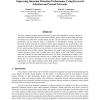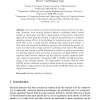27 search results - page 1 / 6 » An Experience Improving Intrusion Detection Systems False Al... |
96
Voted
AINA
2008
IEEE
15 years 6 months ago
2008
IEEE
When traditional firewall and intrusion detection systems (IDS) are used to detect possible attacks from the network, they often make wrong decisions and block the legitimate conn...
154
Voted
DASC
2006
IEEE
15 years 6 months ago
2006
IEEE
— Honeypots are decoys designed to trap, delay, and gather information about attackers. We can use honeypot logs to analyze attackers’ behaviors and design new defenses. A virt...
RAID
1999
Springer
15 years 4 months ago
1999
Springer
The most common computer intrusion detection systems detect signatures of known attacks by searching for attack-specific keywords in network traffic. Many of these systems suffer ...
127
Voted
CORR
2008
Springer
15 years 9 days ago
2008
Springer
Intrusion Detection is an invaluable part of computer networks defense. An important consideration is the fact that raising false alarms carries a significantly lower cost than not...
176
click to vote
ISICA
2009
Springer
15 years 6 months ago
2009
Springer
Abstract. Intrusion detection has been extensively studied in the last two decades. However, most existing intrusion detection techniques detect limited number of attack types and ...


